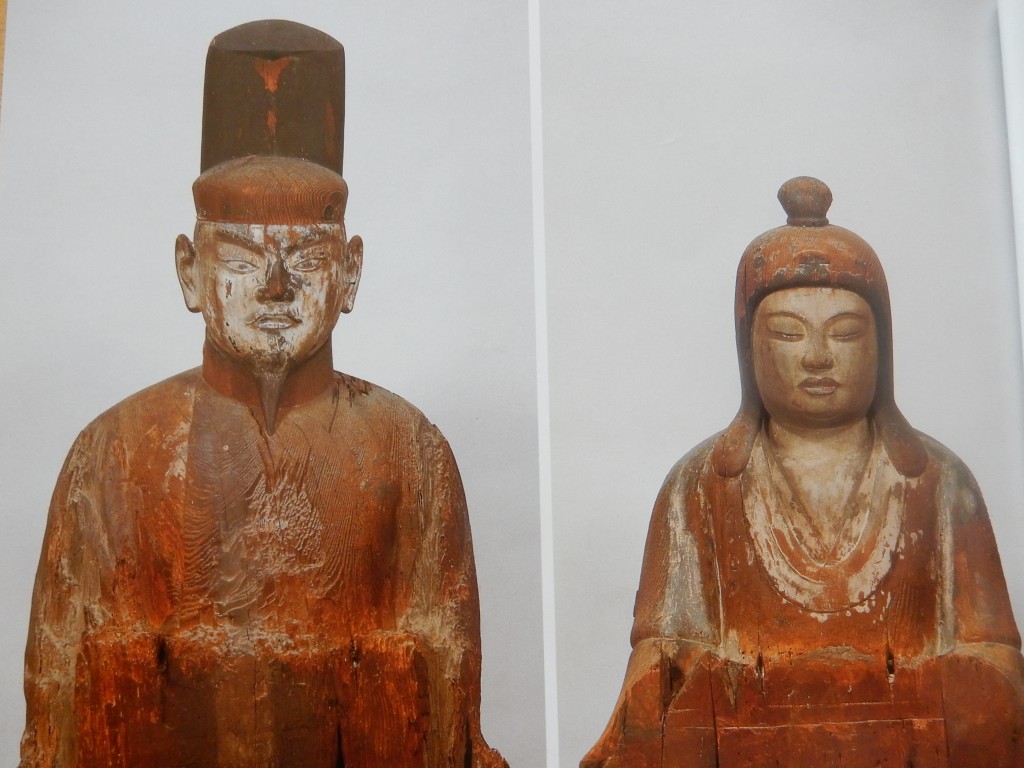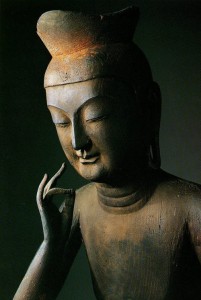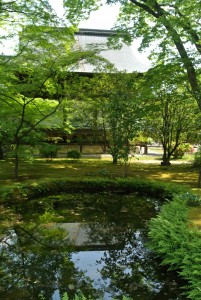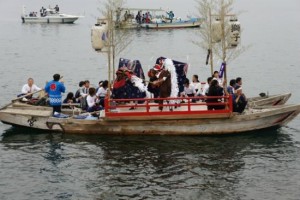
Statue in Koryu-ji of a stern-looking Hata no Kawakatsu, together with his wife
The sixth-century Hata no Kawakatsu was one of the key figures of his time. He was an influential ally of the devout Buddhist Prince Shōtoku, credited with the spread of the new religion in Japan. As a member of the immigrant Hata, Kawakatsu too was receptive to Buddhism and founded Koryu-ji, the first temple to be built in the Kyoto basin. He is also said to have introduced Shinto-style kagura dance/plays into Japan.
According to records left by Noh playwright Zeami, Hata no Kawakatsu fist became known as a young child during the reign of Emperor Kimmei (509-571), when he was discovered by a high court official in a jar near the gates to Miwa Shrine. The official assumed the child to have come from heaven, which was reported to the emperor.
That night the emperor had a dream in which the child said he was the spirit of the first Chinese Qin Emperor. As a result he was introduced to court, later serving as a minister with the name of Hata (the Japanese reading for the Chinese character of Qin).

The famed statue of Miroku Bosatsu, said to have originated in Korea like Kawakatsu himself. (Image courtesy heritageofjapan)
Kawakatsu was asked by Shōtoku Taishi to perform sixty-six dramatic pieces, in order to help settle disturbances in the land. The prince made masks for each piece, and the performances were held at the imperial palace. Since this was successful, Prince Shōtoku decided that this form of entertainment should be maintained, and dubbed it kagura (神楽, entertainment for the gods).
Kawakatsu founded Koryu-ji in 603 after receiving a statue from Shotoku. The temple functioned as a clan temple for the Hata, being known locally as Uzumasa Temple or Hatanokimi Temple. In later centuries it was twice destroyed by fire, but rebuilt. Now a Shingon temple, it is the oldest Buddhist foundation in the Kyoto area and famous for a strikingly graceful Miroku statue whose long fingers extend towards its cheek (though controversial, the statue is thought to be Korean in origin).
According to tradition, Kawakatsu lies buried in a sacred grove on the small island of Ikishima in the Inland Sea (also known as Inamijima). It has a special connection to a shrine on the mainland called Osake Jinja, which uses the island as a ‘tabisho‘ (resting place) during its annual festival in October. Legend says that Kawakatsu often visited the area and villagers built a hill to welcome him, from the top of which is a view over the nearby bay containing Ikishima.

View of Koryu-ji Main Hall. The temple has an Uzumasa-den for veneration of founder, Hata Kawakatsu.
I can only presume that the place had strong ancestral memories for Kawakatsu and the Hata clan as they arrived through the Inland sea from Korea. It’s surely no coincidence that the island name echoes that of Iki Island, one of the stepping stones between Korea and Kyushu. Did Kawakatsu travel to the Osake hill to look pensively at the sea with nostalgic thoughts of his origins overseas? Did he brood on the sea palace that according to mythology lay beneath the watery depths? Did he envisage death as a returning to the sea from where his ancestors had come?
Some six or seven centuries after Kawakatsu’s time a shrine was put up and dedicated to his ancestor, Hata Sake no kimi. It thus bears the same name as the Osake Shrine in Kyoto. (Kawakatsu was a sixth generation descendant of Sake no kimi).
Second in power to legendary Prince Shotoku, Kawakatsu’s time marks a peak in Hata power. Nonetheless a century later the clan founded the large and influential shrines of Matsuo Taisha and Fushimi Inari, as well as working with Emperor Kammu to build a new and permanent capital. But never again would the Hata produce a figure as powerful as Kawakatsu. Buddhist by faith, he is remembered by posterity through the ancestral traditions of Shinto – dead, but not forgotten for the mark he left on Japanese history.

One of the boats in the annual festival of Osake Shrine when mikoshi are taken to Iki Island where Kawakatsu’s grave lies, to the accompaniment of music and kagura performances. (photo courtesy tripadvisor)
For part three of this series on the Hata clan, please click here.
For a full report on the Sakoshi Festival at Osake Shrine, see part 8 here.

Is there any connection between this Miroku and the Inuyasha character?
The Miroku statue, based on the Buddha of the future, is in Kyoto’s Kofuku-ji temple, built by the Hata. Inuyasha on the other hand is a manga with a fictional character named Miroku. So the answer is basically no connection that I’m aware of….